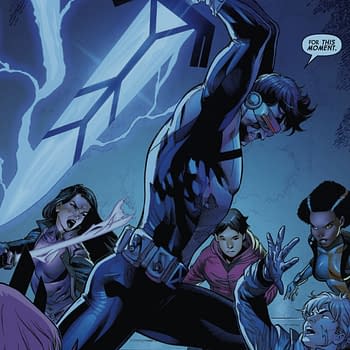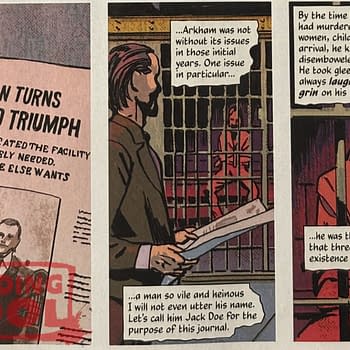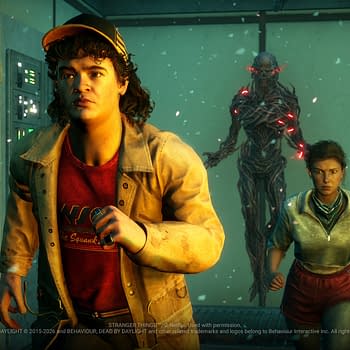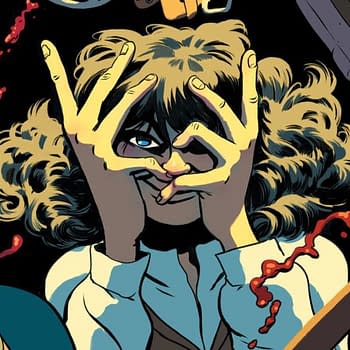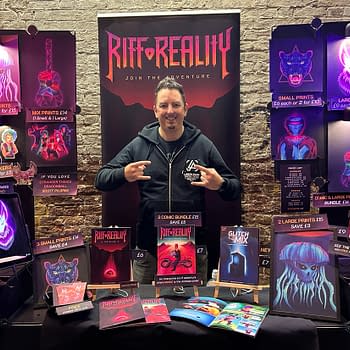Posted in: Comics | Tagged: 2011, Comics, dc, entertainment, gender, gendercrunching, marvel, september
Gendercrunching: DC And Marvel September 2011 – And Marvel 1996-2011
Tim Hanley writes for Bleeding Cool.
September was a surprising month in several ways, with the DCnU books making a disappointing splash, ladywise, while an ignored Marvel quietly had its best month of the year. My apologies for the delay with this month's stats. I know that September was a while ago now, but I was missing one issue that was super tricky to track down, and that held up the whole thing. But here we are now, with a really interesting month to dig into… hopefully the fun stats make up for the lateness.
DC COMICS
Continuing our new format from last month, we're going to run through the monthly numbers all at once. In September 2011, DC Comics put out 67 new comic books featuring 502 credited creators, 449 male and 53 female. Here are the charts:
As we saw in the DCnU-specific Gendercrunching article, the DCnU books didn't cause any sort of precipitous drop overall. This is true of DC as whole for September, with their overall total percentage of female creators down only 0.2% from August. While 10.6% is below average for DC, it's not terribly low.
However, the poor distribution by category we saw in the DCnU continued for the entire line. Six categories were lower or the same as the August totals, most of these on the creative side of things. Cover artists, writers, and pencillers fell to miniscule amounts, while inkers and letterers remained the same at a whopping 1.3% and 0% respectively. Assistant editors were down as well, by over 10%. Colorists saw a nice 1.8% gain, while editors rose almost 10%, but these tiny numbers on the creative side are pretty rough.
MARVEL COMICS
The always busy folks at Marvel put out 99 new comics in September that featured 799 credited creators, 712 male and 87 female. Hold on to your socks, because I'm about to knock them off:
Marvel beat DC. For the first time ALL year, Marvel beat DC. And they registered their highest overall total of the year in doing so. Their 10.9% was up 2% from last month, a huge gain, and marks the first month that Marvel's hit double digits.
In terms of categories, Marvel went up in 6 of 8. Only pencillers dropped, by a tiny 0.3%, and letterers remained the same, of course, at zero. Everything else was up, but there were no huge gains… just consistent, decent increases across the board. On the creative side, colorists saw the biggest gain at 2.8%, and both editorial categories went up by 3-4%. This was a really solid month for Marvel, and I appreciate not having to squint to see the percentage of female creators in most of their categories.
WOMEN AT MARVEL COMICS, 1996-2011
Continuing our historical look at the Big Two, we now turn to Marvel and their women in comics stats for the past 15 years. Last month, we saw no real change overall at DC from 1996 to 2011, and I'm sorry to say that it's a similar situation at Marvel.
The methodology is the same as last month. I tabulated the stats for January and July from 1996, 2001, 2006, and 2011, combined them into yearly totals, and charted them up. Now, these aren't the exact numbers for these years… they're representative, based on two months of data. As such, we're less concerned with specifics for the overall stats so much as trends. There's some wiggle room on the exact numbers, but as a broad comparison we can learn a lot.
It's sure nice to be talking about Marvel for a change, eh? Things have been pretty hardcore DC for a while with the relaunch and all… this is refreshing. Here are the numbers for female creators… we have our usual eight categories, and "All" represents the total percentage of creators overall (ie. the stats we usually do with a pie chart):
And here's the chart, which will help us see the trends more clearly:
Let's hit the glaring, shocking category first: Marvel used to have female letterers!! And in the double digits for 2001 even… my mind is blown. Marvel's had ONE female letterer all year, so to see that their used to be a fair percentage of them is amusing. DC has a similar trend with their letterer numbers as well, with higher totals in 1996 and 2001 dropping to tiny numbers in 2006 and 2011.
Similarly, colorists are another area where Marvel and DC followed the same pattern. Overall, the percentage of female colorists has gone down by more than half over the past 15 years at Marvel. The colorist drop was more extreme at DC, while the letterer drops was more extreme at Marvel, but between both publishers I think it's fair to say that there's an industry-wide drop in both of these gigs. Which is sort of odd, considering that colorists are regularly the best creative category for women… it used to be even better!!
Editorially, Marvel's had a bit of a rollercoaster. Assistant editors got consistently better from 1996 to 2006, then shot up like crazy in 2011, and it's nice to see continual growth there, but regular editors were all over the place. Ultimately, I think it's valuable to look at where they were 15 years ago and where they are now, and it's a slight drop. Marvel went up and down wildly in the intervening years, but overall the net change is slightly to the negative. However, there's strong growth from 2006 to 2011, which is a positive.
Artwise, Marvel's been unremarkable. These are pretty consistently low numbers, with only slight variations. For both publishers, hiring for female pencillers and inkers has been negligible at best. I don't know whether this is due to a lack of female artists or certain style preferences, but these numbers are extremely small. Cover artists have seen some nice gains in the past five years, though. They've jumped to a very respectable rate, especially compared to interior artists.
The biggest jump on the creative side comes from writers, who have moved from persistent sub-2% numbers to over 5% in 2011. Female writers have been one of Marvel's biggest strengths this year, and given their past totals it's clear that they're now putting a concerted effort into bolstering their ranks. I think this is one of the ways that Girl Comics succeeded… although other creative categories haven't really picked up, a lot of the female writers involved have been getting consistent work since.
Now for the overall total… there were a few gains and a few losses across the board, but much like with DC we're seeing little to no change overall. The total percentage of female creators in 1996 was 8.4%, and in 2011 it's 8.7%, with slight deviations in between. This is not a statistically significant difference at all. By category, their numbers are up and down like a yo-yo, but overall their growth is stagnant. That's rather disappointing.
Fifteen years is a long time. Fifteen years ago, Marvel's big thing was the Onslaught saga… well, their big thing was going bankrupt, but Onslaught was their main story. Then you got Heroes Reborn, where everything looked all Liefeldian and feet didn't matter. Their main product was testosterone-fueled battling. Not that testosterone-fueled battling isn't an integral part of comics today, but the market has changed. The fan base is shifting… comic books have gone mainstream, and the audience is more diverse. But the creators aren't. Most of the categories have fluctuated here and there, but altogether nothing has really changed inside Marvel in fifteen years. Everywhere you look, there seem to be more and more women reading comics and writing about comics, and many that are making their own webcomics and small press books. But inside Marvel, there's been no growth for fifteen years. Marvel's missing the boat… no one expects things to be 50-50, or for a publisher to radically restructure the types of comics they publish, but the number of women AROUND comics is increasing all the time while the number of women IN comics is remarkably stagnant. This just seems like a MASSIVE missed opportunity to me.
NOTES:
To learn more about this statistics project and its methodology click here, and to see the previous stats click here. If you want to see full spreadsheets and data for any of the stats discussed above, please contact Tim.
You can visit Tim at Straitened Circumstances and follow him on Twitter @timhanley01.










